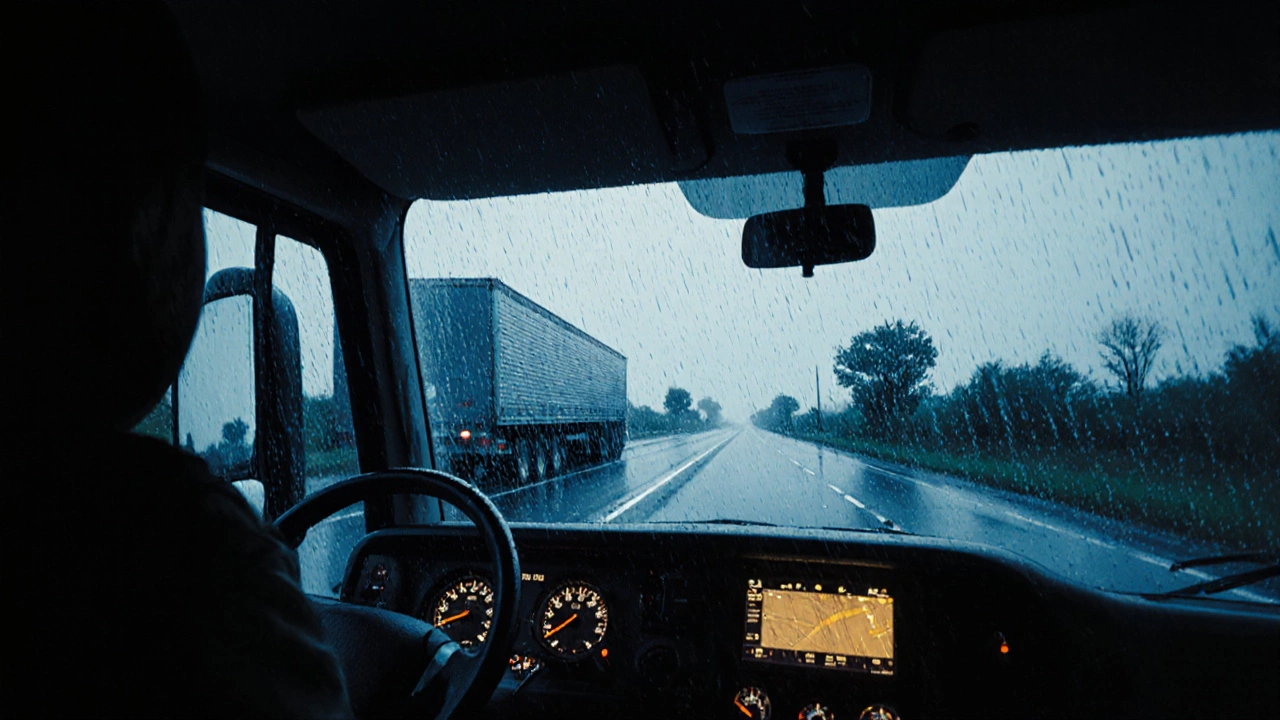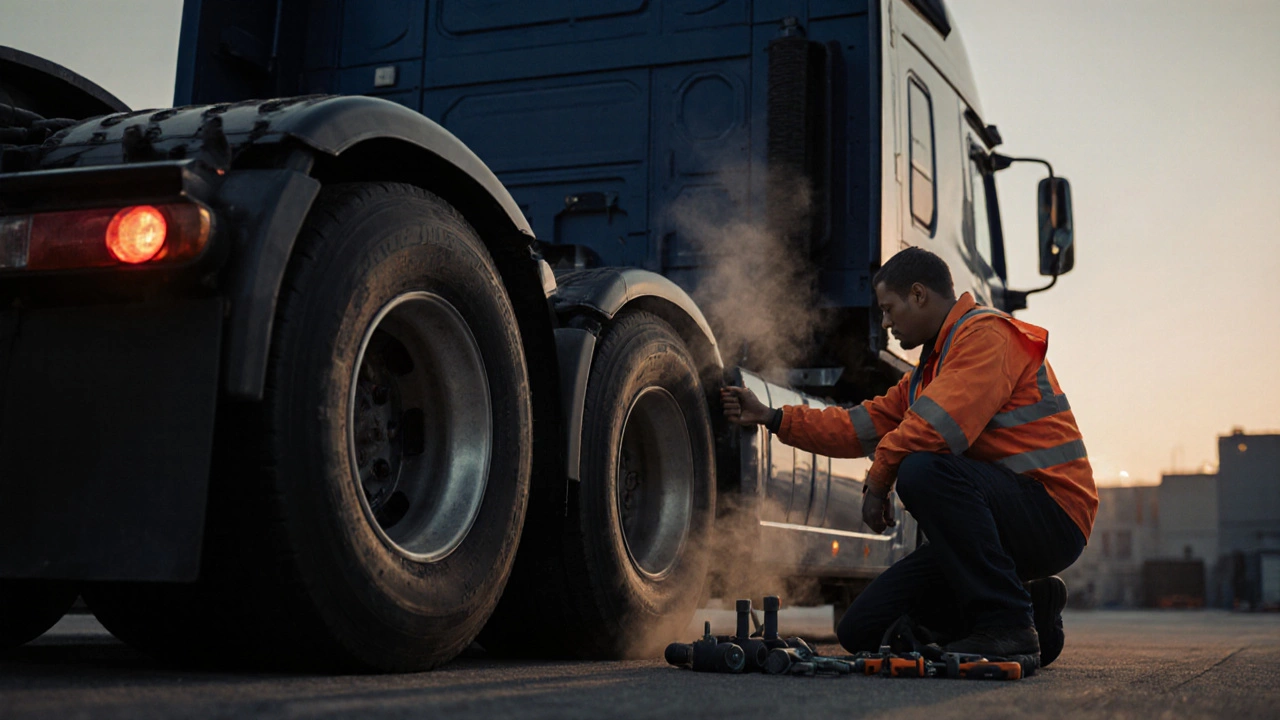HGV Earnings Calculator
How much could you earn as an HGV driver?
Estimate your potential earnings based on your experience and job type
Estimated Earnings
Based on NZ market dataYour estimated hourly rate:
What this means for your income:
Ever wonder what it’s really like to drive a heavy goods vehicle? It’s not just about steering a big truck. HGV driving is a mix of skill, responsibility, and strict rules that keep roads safe and goods moving. If you’re thinking about becoming an HGV driver, you need to understand how the whole system works - from getting your licence to hauling freight across the country.
What Exactly Is an HGV?
An HGV stands for Heavy Goods Vehicle. In New Zealand, this covers any vehicle over 3,500kg gross vehicle mass - think large trucks, articulated lorries, refrigerated trailers, and even some specialized haulage vehicles. These aren’t your everyday cars. They can weigh up to 44 tonnes when fully loaded. That’s the same as about 30 compact cars stacked together.
HGVs are split into categories based on weight and configuration:
- Category C: Rigid trucks over 3,500kg - like delivery vans turned big rigs.
- Category C1: Medium-sized rigid trucks between 3,500kg and 7,500kg.
- Category C+E: Articulated trucks - the classic tractor unit pulling a trailer.
- Category C1+E: Medium rigid truck with a trailer over 750kg.
Each category needs a separate test. You can’t just jump into driving a 44-tonne rig without training for it.
How Do You Get an HGV Licence?
Getting an HGV licence isn’t like renewing your car licence. It’s a multi-step process that takes weeks, sometimes months, depending on your experience and how quickly you train.
- Hold a full car licence - You must already have a valid Class 1 (car) licence before applying for any HGV class.
- Pass a medical check - The NZ Transport Agency (NZTA) requires a medical form signed by your doctor. This checks vision, blood pressure, heart health, and anything that could affect safe driving.
- Apply for a learner HGV licence - You’ll need to pass a theory test covering road rules, vehicle safety, and load security. This isn’t just a multiple-choice quiz - you need to understand why certain rules exist.
- Complete HGV training - You can’t just book a test. You must train with an approved instructor. Most people take 10-20 hours of lessons before they’re ready.
- Pass the practical driving test - This includes a pre-trip inspection, off-road manoeuvres, and on-road driving. The test is tough. Examiners look for smooth control, awareness of blind spots, and correct use of mirrors.
Once you pass, your licence will show the categories you’re qualified for. You can’t drive a C+E vehicle until you’ve passed that specific test - even if you already have a C licence.
What Does HGV Training Actually Involve?
Training isn’t just about driving. It’s about learning how to handle a vehicle that takes 50 metres to stop at 90km/h and can’t turn like a car.
Here’s what a typical training course covers:
- Vehicle controls - Understanding dual air brakes, retarders, gearboxes with 12+ speeds, and how to shift smoothly without jerking the load.
- Blind spot management - HGVs have massive blind spots, especially on the right side. Training teaches you how to check mirrors, use cameras if fitted, and when to stop before turning.
- Load securing - You’re legally responsible for how your cargo is tied down. Training shows you how to use straps, chains, and load bars properly. A loose pallet can kill someone.
- Route planning - Not every road can handle a 44-tonne truck. You learn to avoid low bridges, narrow streets, and weight-restricted zones using digital tools and maps.
- Hours of service rules - Drivers can’t drive more than 10 hours in a day without a 10-hour break. Training explains how to log rest periods and avoid fatigue.
Most training schools use simulators to practice emergency stops, skid recovery, and coupling trailers before you even get behind the wheel. It’s not flashy - but it saves lives.

What’s a Typical Day Like for an HGV Driver?
It’s not all open highways and scenic views. A day starts before sunrise.
Most drivers arrive at the depot by 5:30am. First thing: check the vehicle. You walk around the truck, checking tyres, lights, fluid levels, and brake lines. If something’s wrong, you report it - even if it’s a small crack in a mirror. That’s part of the law.
Then you load. You might be hauling steel coils, frozen meat, or pallets of electronics. You need to know how to balance weight, secure loads, and ensure nothing shifts during transit.
On the road, you’re constantly scanning. HGV drivers watch for pedestrians, cyclists, and cars cutting in. You don’t speed. You don’t tailgate. You leave space - because stopping takes time.
Breaks are mandatory. After 4.5 hours of driving, you must take a 45-minute break. Many drivers use this time to stretch, eat, and check their route on the GPS. Some use apps that alert them to road closures or weather warnings.
End of day? You might be back at the depot by 6pm - or you might be sleeping in a truck stop 200km away. Long-haul drivers often spend days away from home. It’s not a 9-to-5 job.
Why Is HGV Driving So Regulated?
It’s not bureaucracy - it’s safety.
Statistics from NZTA show that HGVs are involved in fewer accidents per kilometre than cars, but when they do crash, the results are far more serious. A truck rollover can block a highway for hours. A poorly secured load can fly into oncoming traffic.
Regulations exist because:
- Trucks have longer stopping distances - you need to anticipate stops 3x further than a car.
- Wind affects large vehicles - side winds can push a loaded trailer sideways.
- Driver fatigue is a real risk - long hours, irregular sleep, and pressure to meet deadlines can lead to mistakes.
That’s why you need medical checks, training, logbooks, and regular vehicle inspections. It’s not about control - it’s about preventing tragedies.
How Much Can You Earn as an HGV Driver?
Pay varies based on experience, type of work, and hours.
- Entry-level (C licence): $25-$30/hour - local deliveries, warehouse runs.
- Experienced (C+E licence): $30-$40/hour - long-haul, refrigerated, or hazardous goods.
- Specialist roles: Tanker drivers, oversize load haulers, or mining haulage can earn $45+/hour.
Many companies offer bonuses for on-time deliveries, clean safety records, or completing extra training. Some drivers make $70,000-$90,000 a year - and that’s without overtime.
It’s not easy work, but it’s stable. There’s a shortage of qualified HGV drivers in New Zealand. Demand is growing as e-commerce expands and infrastructure projects ramp up.
What Are the Biggest Challenges?
Let’s be honest - it’s not all paychecks and freedom.
The toughest parts:
- Isolation - You spend hours alone. No one to talk to. It can get lonely.
- Physical strain - Loading/unloading, climbing in and out of cabs, sitting for hours - it wears on your body.
- Weather - Rain, wind, fog, and icy roads make driving harder. You need to adapt fast.
- Pressure - Deadlines are tight. Delays cost money. But you can’t rush safety.
Good drivers learn to manage stress. They stick to routines, stay hydrated, and take breaks seriously. It’s not just about driving - it’s about staying mentally sharp.
What’s Next After Getting Your Licence?
Getting your licence is just the start.
Most new drivers begin with local deliveries - milk runs, construction supplies, or retail freight. After a year or two, you can move into long-haul or specialist roles. Many drivers later train to become instructors, fleet managers, or even start their own haulage businesses.
There are also ongoing training requirements. Every five years, you need to renew your licence and complete a refresher course. Some employers require annual safety workshops.
Technology is changing too. New trucks have automatic braking, lane assist, and telematics that track your driving. Learning to use these tools makes you more efficient - and safer.
Is HGV Driving Right for You?
If you’re patient, detail-oriented, and don’t mind being on your own for long stretches - then yes.
If you hate routine, get anxious behind the wheel, or can’t handle pressure - it’s not the job for you.
It’s not glamorous. But it’s essential. Every product you buy, every meal you eat, every piece of equipment used in hospitals and schools - it all moved on an HGV.
Driving one isn’t just a job. It’s a responsibility. And if you’re ready for that, the road is open.
Do I need a medical certificate to get an HGV licence in New Zealand?
Yes. You must complete a medical form (Form 201) signed by your doctor. It checks vision, hearing, cardiovascular health, and any conditions that could affect your ability to drive safely. If you have diabetes, epilepsy, or a history of heart issues, you may need additional tests or clearance from a specialist.
Can I drive an HGV with a car licence?
No. A standard car licence (Class 1) only allows you to drive vehicles under 3,500kg. To drive any heavy goods vehicle - even a large delivery truck - you need a separate HGV licence (Class 2 or 3). You must pass both a theory test and a practical driving test for the specific category you want.
How long does HGV training usually take?
Most people need between 10 and 20 hours of professional training before they’re ready for the test. If you have no prior experience with large vehicles, you might need more. Training schools often offer packages of 15 hours with practice tests included. The key is not how many hours, but how confident you feel behind the wheel.
What’s the difference between a C and C+E licence?
A Category C licence lets you drive rigid trucks - like a big box truck with no trailer. A C+E licence lets you drive an articulated truck - the kind with a tractor unit pulling a semi-trailer. C+E is harder to get because it involves coupling and reversing with a trailer, which requires more skill. Most long-haul drivers need C+E.
Can I train for an HGV licence while working full-time?
Yes, but it’s challenging. Most training schools offer lessons on weekends or early mornings. You’ll need to block out time for theory study, practical lessons, and practice driving. Many people take 3-6 months to complete everything while working. If you can afford to take time off, you’ll progress faster.

